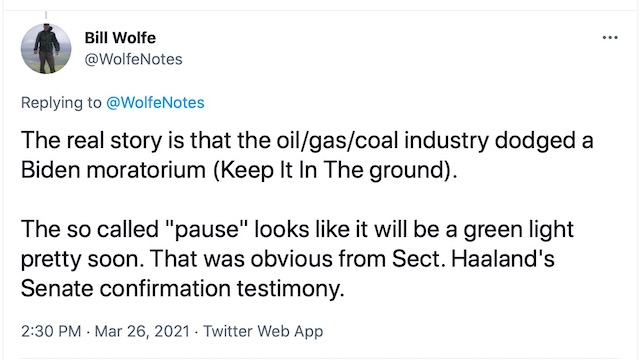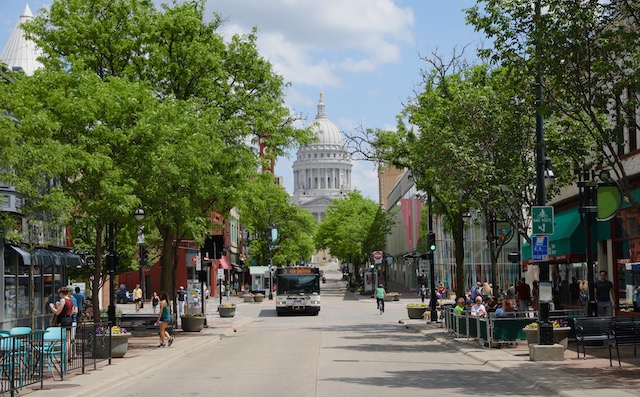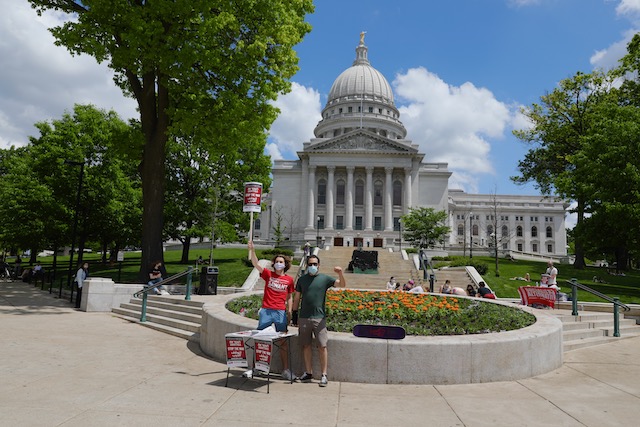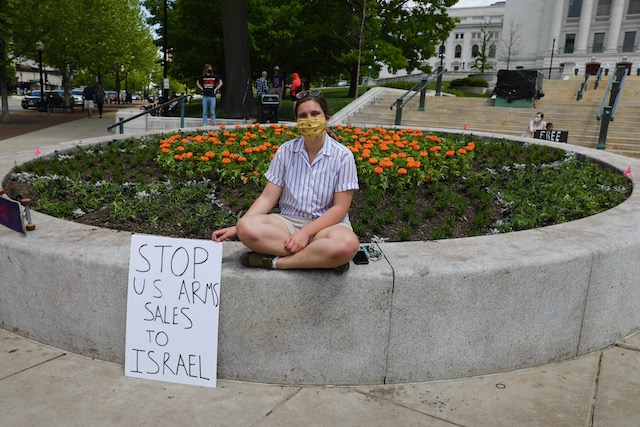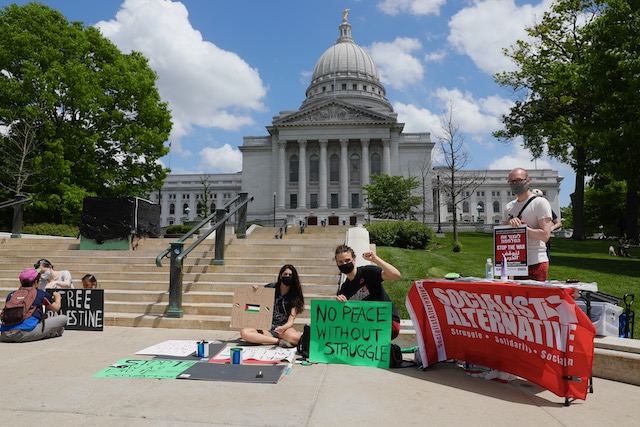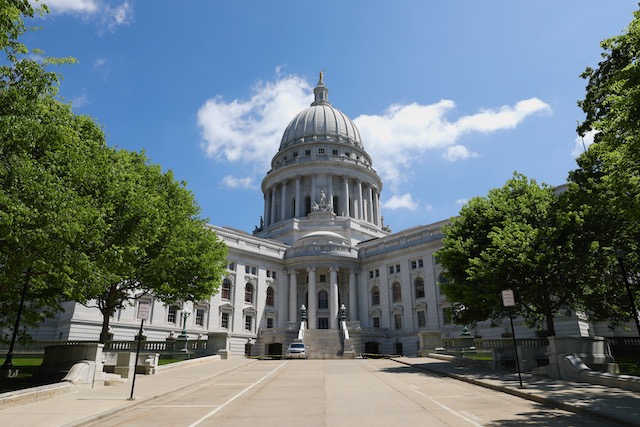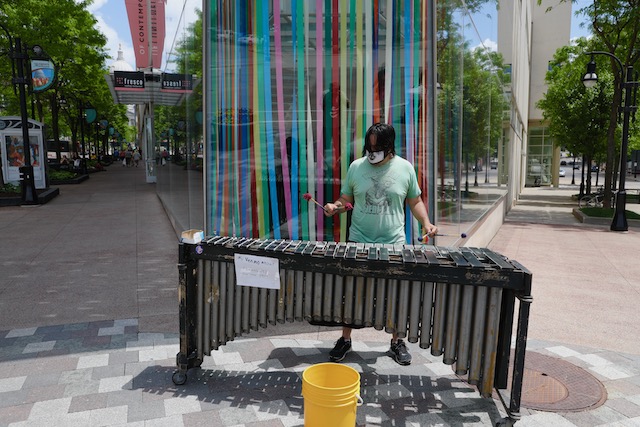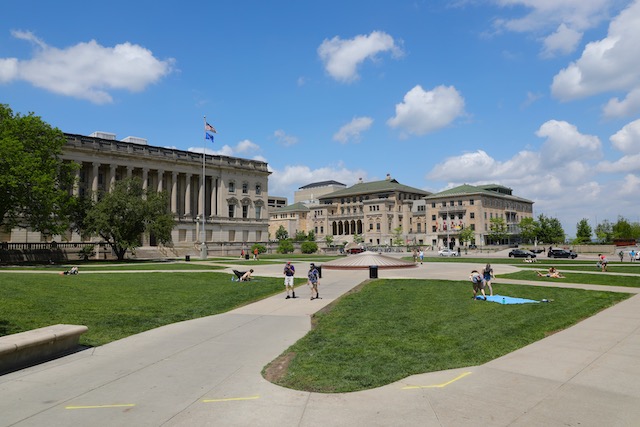DEP Plan Required To Ratchet Down On Pollution To Attain Federal EPA Clean Air Act Ozone Standards
An Example Of Gaslighting: Rhetoric Versus Regulation
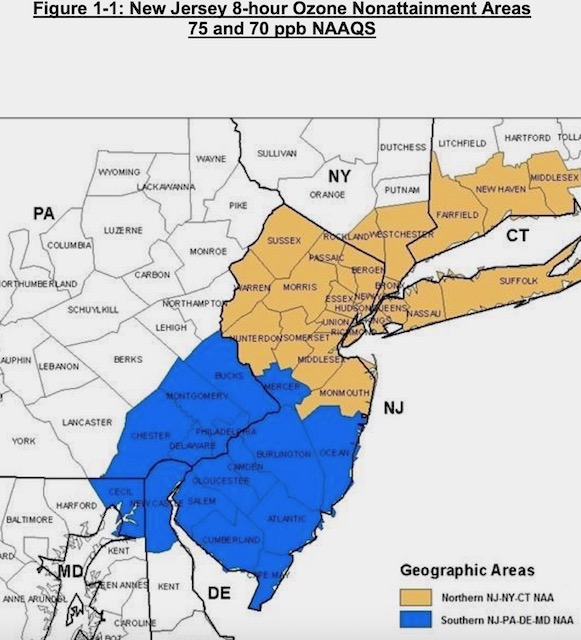
[Update below]
The Murphy DEP just proposed revisions to NJ’s federal Clean Air Act mandated State Implementation Plan (SIP), see:
The Ozone SIP has huge implications for public health, environmental justice, reducing greenhouse gas emissions, and conversion of NJ’s transportation sector to zero emission electric vehicles.
The “mobile source” powers even provide back door land use leverage to restrict or effectively block traffic intensive land uses, like warehouses (e.g. just think if DEP mandated that new warehouses not only had to be net zero emissions, but also had to have 100% electric trucks. Solar ready? that’s political cover, not science based policy).
The SIP revisions were required by US EPA in order to demonstrate how NJ would come into compliance with federal EPA’s ground level ozone standards – technically the entire state of NJ is in “non-attainment” status for ozone and the problem is serious and getting worse. According to DEP’s SIP revision:
The purpose of this State Implementation Plan (SIP) revision is to address the requirements of the Clean Air Act (CAA) regarding New Jersey’s plan for attaining the 2008, 75 ppb 8-hour ozone National Ambient Air Quality Standard (NAAQS) in its Northern New Jersey multi-state nonattainment area by its attainment date of July 20, 2021. This nonattainment area was reclassified from moderate to serious by the United States Environmental Protection Agency (USEPA) effective on September 23, 2019.
It is not clear, but I suspect that a more restrictive plan is required to meet the lower existing 70 ppb standard -which scientists have criticized as inadequately protective:
- On December 23, 2020, the [Trump] U.S. Environmental Protection Agency (EPA) acted to retain, without revision the primary and secondary ozone National Ambient Air Quality Standards (NAAQS). The standards, established in 2015 by the Obama-Biden Administration, are set at 70 parts per billion (ppb), in terms of a 3-year average of the annual fourth-highest daily maximum 8-hour average ozone concentrations.
A huge coalition of scientists, environmental groups criticized the Trump EPA for retaining that 70 ppl Obama EPA standard: (WaPo)
“There is powerful, overwhelming evidence that shows that this standard is not adequate to protect the health of Americans,” the group said in a statement. “EPA’s proposal violates the core purpose of these standards under the Clean Air Act: to protect public health with an adequate margin of safety.”
Curious, those same groups were silent when the Obama EPA withdrew and later adopted that “inadequate” standard (something we wrote about at the time (Obama’s first term) and later during Trump’s EPA.)
Regardless, there is no doubt that ground level ozone is a significant threat to public health. NJ has failed to attain the ozone standard for decades.
Ozone pollution disproportionately impacts urban “environmental justice” communities and is exacerbated by increasing temperatures driven by the climate emergency (i.e. see: “urban heat island” effect). Many ozone precursors are volatile organic compounds that are hazardous air pollutants (HAPs) that cause serious public health impacts and risks, like cancer. Many pollution sources have localized “hot spot” and “cumulative impact” environmental justice concerns . Many ozone precursor pollutants also contribute to global warming and their effects are magnified by global warming.
DEP’s own Climate Science Report (July 2020) noted the interactions between ozone and climate and EJ:
Increases in temperature expected as a result of climate change could intensify air pollution as well as respiratory and cardiovascular health concerns. Such impacts are of particular concern for already overburdened environmental justice communities.
But when it comes to putting that science and press release rhetoric into enforceable regulations, DEP takes a walk.
Remarkably, none of this is even mentioned – never mind addressed – in the DEP’s SIP.
The climate and EJ issues, however, ARE included in the SIP, but only in rhetoric, not in regulation – a critical distinction.
But these issues are implicit and DEP evasively alludes to these issues, but ultimately dismisses them as “Another complexity”:
Another complexity involves the nonlinear relationship between NOx and VOC levels and ozone formation. Areas, such as the majority of the landscape in the OTR, that have extensive forests that produce high levels of isoprene and other VOCs during the summer month achieve the best ozone reduction through reductions in regional NOx, but dense urban areas such as New York City that lack natural VOC production can be VOC limited, and in some cases NOx reductions increase ozone levels due to less NOx being available to destroy already formed ozone through titration.
Serious consideration of climate and environmental justice would force radical changes in DEP’s air quality planning and regulatory programs – from everything from the location of air monitoring stations to the scientific methods for risk assessment and air quality modeling.
But despite the passage of recent environmental justice legislation and the 2007 Global Warming Response Act, DEP has not even begun to make these kind of changes, as this SIP reveals.
In addition to neglecting climate and environmental justice, quite honestly, I could not understand the specific regulatory mandates DEP was planning in order to reduce pollution levels necessary to attain the EPA standards (unless all that is implicit in the models). Let’s hope EPA holds NJ’s feet to the fire on that and makes critical issues transparent.
So, here’s some background on the DEP plan and suggestions on how to pierce the regulatory jargon and spin to read this complex document.
The core elements of the DEP SIP plan are called “Control Measures” (see Chapter 3) – they are regulatory mandates on industry that require specific reductions in emissions of chemical pollutants that cause or contribute to the formation of ground level ozone.
In accordance with Section 172(c)(1) of the CAA (or 42 U.S.C. §7502(c)(1)) states are required to implement all RACM as expeditiously as practicable as part of their effort to attain the NAAQS.
But even in Chapter 3, keep an eye out for DEP weasel words, like this:
State Voluntary Mobile Measures
Emission reduction estimates in this section are not being relied on to meet any required SIP milestones but support the States goal of ozone attainment.
The SIP also must include an “Attainment Demonstration” (see Chapter 6) that provides the data and modeling on exactly how the mandatory reductions will attain the ozone standards.
NJ based petro-chemical, pharmaceutical, and energy Industries have long strongly opposed DEP regulatory mandates to ratchet down on pollution, often blaming “mobile sources” (cars and trucks) for the problem. DEP has long deferred to these self serving industry arguments and delayed the necessary ratchet down on pollution controls on both industrial and mobile sources required to achieve the ozone standards and protect public health.
Historically, to mask these failures and avoid accountability – going back to the Whitman “open for business” administration – DEP and NJ industry have claimed that out of state pollution is the major cause of the problem.
The Murphy DEP continues to assert this lame excuse:
The transport of ozone from sources upwind of the nonattainment area continues to contribute significantly to the poor ozone air quality in the Northern NJ-NY-CT nonattainment area, particularly at monitors located in Connecticut. […]
Modeling Studies Confirm That Emissions From New Jersey Sources Do Not Significantly Contribute to the Remaining Nonattainment Area Ozone Levels
The results of recent ozone source apportionment modeling and zero-out ozone sensitivity modeling demonstrate that New Jersey actions by themselves, regardless of stringency, are insufficient to achieve attainment levels of ozone in the nonattainment area.
The DEP also has engaged in a lot of finger pointing, by blaming EPA and other states. The Murphy DEP continues this bureaucratic game – an incredible hypocrisy given NJ’s proposed major increase in transportation related emissions (new roads (and ports and airports) like the Turnpike and GS parkway expansions, create more vehicle miles travelled, and more pollution from mobile sources): Here’s DEP finger pointing:
Mobile Source Rules: Upwind states should adopt mobile source measures similar to those in New Jersey such as the California Low Emission Vehicle Program. The USEPA must also do its part to address mobile source emissions that contribute the largest portion of total NOx emissions within the nonattainment area as well as the region.
This behind the scenes industry lobbying and bureaucratic finger pointing largely explain why NJ has failed to attain federal EPA ozone standards.
The Murphy DEP has even gone so far as to echo the polluters’ discredited economic attacks and blame public health protection and environmental regulations for economic growth concerns. I’ve heard this Big Lie spouted by the Chamber of Commerce and NJ BIA for decades, so its disturbing to find it in the DEP’s own SIP:
New Jersey does not yet meet the federal ozone NAAQS. Therefore, the federal Clean Air Act requires new sources of NOx (e.g., power plants) and VOCs (e.g., gasoline refineries) to offset their NOx and VOC emissions by buying emissions “credits” that are sold by other facilities. Emissions offset credits can be costly and time-consuming to obtain, which is an added burden on new businesses or existing businesses that want to expand. Some upwind neighbors contribute significantly to New Jersey’s ozone problem, but they do not have to comply with the “offset” requirements that sources in New Jersey do if those states meet the ozone standard. Thus, a company that wants to build a facility in the Northeast might find states upwind of New Jersey more economically attractive.
Amazingly, not one NJ environmental group, public health group, or environmental justice group requested that DEP hold a public hearing on this SIP revision, which has tremendous implications for air quality, public health, and climate justice.
As I’ve written many times, the Foundations do not fund this essential regulatory work and therefore NJ environmental groups no longer do it.
Just as remarkably, DEP used this ENGO failure to cancel the scheduled public hearing on the proposed SIP revisions. Just what the corporate polluters wanted, as they remain below the radar. Here’s is DEP’s public notice:
Take notice that the New Jersey Department of Environmental Protection (NJDEP) will not be holding a public hearing on July 13, 2021, or on another date, because a public hearing was not requested.
So, let me just highlight the major flaws in the SIP revision. Keep in mind that the core regulatory requirements that actually require that pollution emissions are reduced are established in the “Control Measures” (Chapter 3) and “Attainment Demonstration” (Chapter 6).
It is critically important to keep this in mind because the DEP Ozone SIP plan does include a lot of rhetoric – which has no regulatory meaning and is not enforceable – about climate change and environmental justice. Basically, DEP inserted the text of a press release in a regulatory plan – but it was done in a way that is not enforceable (or subject to EPA oversight).
This distinction between rhetoric and binding regulations exposes the Murphy DEP Ozone SIP as a highly misleading fraud.
Similarly, it is critically important to distinguish actual regulatory controls with plans to develop future regulatory controls.
It is also critical to distinguish quantified pollution emissions reductions with rhetorical assertions and aspirational goals.
The Murphy DEP plan is largely written in the future tense and does not quantify emissions reductions associated with either future proposals or rhetorical program assertions (unless all that is implicit in the models). Here is a perfect example of that:
New Jersey is in the process of preparing the following rules to address NOx and VOCs. […]
The Murphy DEP plan includes a lengthy Executive Summary that rhetorically describes various air pollution related programs and State funding for those programs.
But there is a huge difference between air pollution related programs and program funding and actual biding, quantified, and enforceable regulations on pollution reductions.
Finally, it is important to distinguish taking credit for prior accomplishments with current and binding future regulatory actions.
The Murphy DEP SIP is loaded with descriptions of prior actions, but very thin on current and binding future regulatory mandates.
For all these reasons, the headline correctly notes that the DEP SIP “ignores” climate and environmental justice – because it does so rhetorically and not with science and binding regulation.
The essential distinction that must be kept in mind while reading the document is between an enforceable regulatory standard and a press release.
So, with that context in mind, here are the major flaws.
1. DEP’s Ozone SIP Revision Ignores Climate Emergency
The DEP SIP (see Chapters 3 and 6) does not include a discussion of the relationships between ozone and GHG emissions or the climate emergency.
The DEP SIP does not include enforceable mandatory pollution emissions reductions regarding greenhouse gases and NJ’s aspirational 80% GHG reduction goal in the Global Warming Response Act.
Here’s how DEP rhetorically addresses climate: (emphases mine):
NJ PACT
In addition to the above legislation, Governor Murphy signed Executive Order Number 100 (EO 100) on January 27, 2020 that initiated a targeted regulatory reform effort that will modernize New Jersey environmental laws. EO 100 is referred to as Protecting Against Climate Threats (NJ PACT). NJ PACT will usher in systemic change, modernizing air quality and environmental land use regulations, that will enable governments, businesses and residents to effectively respond to current climate threats and reduce future climate damages.
As a national leader in environmental protection, over the next two years, the NJDEP will create a regulatory roadmap to reduce emissions, build resilience, and adapt to a changing climate. This includes the enactment of new air pollution regulations that achieve critically needed reductions in carbon dioxide and short-lived climate pollutants (e.g., methane and black carbon) including technology-forcing measures that pave the way for a clean-energy economy. A number of the new air pollution regulations promulgated pursuant to the NJ PACT to address carbon dioxide and SLCPs will also have the co-benefit of reductions of emissions of ozone precursors.
And notice how DEP just again quietly delayed the implementation date of the climate PACT regulations by 2 years! (BTW, if you hit that link, notice that DEP has taken down all the PACT Stakeholder meeting information, including the specific lists of regulations that DEP pledged to revise to address climate. This makes it impossible for the public to see what rules must be revised and allows DEP to spoon feed single rules to manipulate perception of DEP progress. So, when they put up their monitoring/reporting rule, it makes it look like they’re doing a lot when they’re not).
2. DEP’s Ozone SIP Revision Ignores Environmental Justice
Environmental justice is given similar rhetorical treatment – where aspiration goals, programs and funding are described, but there are no quantified and mandatory actual pollution emissions reductions, especially in environmental justice communities (which are not part of DEP’s air quality monitoring, modeling, or risk assessment programs):
Finally, on February 16, 2021, Governor Murphy announced an investment of more than $100 million in clean, equitable transportation projects that will improve air quality and reduce the effects of climate change while moving New Jersey towards 100 percent clean energy by 2050 . Leveraging proceeds from RGGI and the Volkswagen Mitigation Trust Funds will bring electrification programs, equitable mobility projects, and electric charging infrastructure to New Jersey’s environmental justice communities.
There is no doubt the these are complex issues and that DEP has historically implemented a fairly rigorous air quality program.
But that was longs ago and DEP continues to rest on those laurels instead of making the radical changes demanded by the climate emergency and environmental justice.
And the Foundations, environmental groups, and media have totally abandoned this field, so there is no accountability – the entire DEP air quality planning and regulatory program has devolved to cheerleading for political rhetoric.
[End Note:
The DEP SIP also includes a pollution emissions inventory (for ozone precursors, but the thresholds are high for including an emission source).
But among all the data tables and pie and bar charts, you can not find the names and locations of individual corporate polluters or industrial facilities (aside from the consent decrees at mostly refineries).
The manner in which DEP presents the emissions inventory data provides cover for corporate polluters.
It is totally useless for citizens seeking to identify. pollution sources in their communities.
This too must change.
[Update:
I have written many times about very similar failures in the NJ DEP’s air toxics regulatory program and explained why the recent NJ environmental justice law will not fix them, so I thought I’d put all those posts together here for the curious reader/activist or intrepid journalist, see:
end update]
